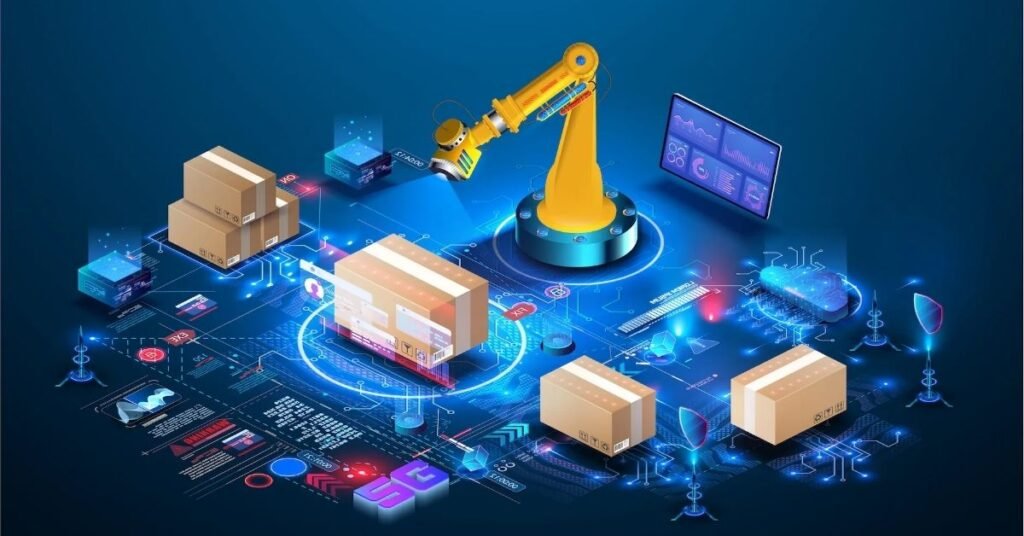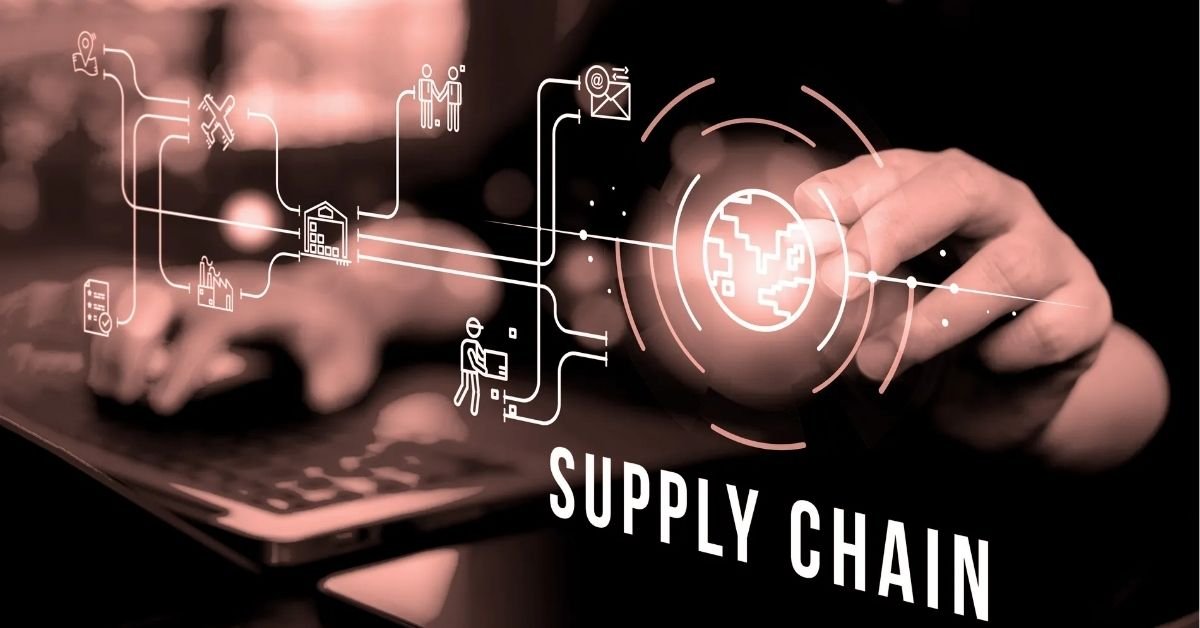In 2025, supply chain disruptions fueled by geopolitical tensions, climate challenges, and labor strikes have made AI Supply Chain Efficiency a top priority for U.S. companies.
From port bottlenecks to unpredictable demand, traditional logistics models are struggling to keep up. Enter artificial intelligence (AI), which is revolutionizing supply chain management with predictive analytics, automation, and real-time insights.
As businesses like Amazon and Walmart harness AI to streamline operations, the AI Supply Chain Efficiency movement is reshaping how goods move across the U.S. and beyond.
This article explores the technologies, benefits, challenges, and future of AI-driven supply chains.
AI Technologies Driving Supply Chain Transformation
The AI Supply Chain Efficiency boom is powered by cutting-edge technologies tailored to logistics challenges.
Predictive analytics processes vast datasets, sales trends, weather patterns, and geopolitical events to forecast demand with pinpoint accuracy.
Machine learning (ML) models refine these predictions over time, learning from real-time data to optimize inventory and routes. Automation, including robotic process automation (RPA), streamlines repetitive tasks like order processing and warehouse picking.

Internet of Things (IoT) integration, using sensors on equipment and vehicles, provides real-time data on performance and conditions, enabling proactive maintenance.
Together, these tools create dynamic, responsive supply chains, as noted in a 2025 Deloitte report, enhancing visibility and decision-making for U.S. firms.
U.S. Companies Leading the Charge
U.S. companies are at the forefront of adopting AI Supply Chain Efficiency solutions.
Amazon’s multi-layered AI systems optimize procurement, warehousing, and last-mile delivery, boosting picking efficiency by 50% and saving $1 billion annually in inventory costs, per a 2024 Deloitte survey.
Walmart uses AI to pre-qualify alternative suppliers, ensuring resilience during disruptions like the 2025 East Coast port strikes.
Tyson Foods employs IoT sensors and ML to monitor equipment health, reducing downtime by 20% and cutting repair costs.
Church Brothers Farms, a California-based produce company, leverages ThroughPut’s AI demand-sensing tools to align production with market trends, minimizing food waste by 15%.
These examples highlight how AI Supply Chain Efficiency delivers tangible results across industries.
Benefits: Cost Savings, Resilience, and More
The adoption of AI Supply Chain Efficiency offers compelling benefits. Predictive analytics reduces forecast errors by up to 30%, as seen with Unilever’s $300 million inventory cost savings.
Automation cuts logistics costs by 15% and improves service levels by 65%, according to a 2022 McKinsey survey.
Real-time route optimization, powered by generative AI, minimizes delays and fuel use, enhancing sustainability.
Maersk reported a 12% reduction in fuel consumption. AI also bolsters resilience by identifying risks, like supplier disruptions, before they escalate, enabling firms to pivot swiftly.
For U.S. consumers, this translates to faster deliveries, fewer stockouts, and lower prices, making AI Supply Chain Efficiency a win for businesses and customers alike.
Challenges and Risks to Adoption
Despite its promise, the AI Supply Chain Efficiency faces hurdles. High implementation costs, ranging from $500,000 to $2.5 million, strain budgets, with 62% of initiatives overshooting estimates.
Data quality issues consume 60–70% of project budgets, as poor data leads to inaccurate insights. Workforce resistance is another barrier; 72% of failed implementations cite employee pushback, per a 2024 Deloitte survey.
Ethical concerns, including data privacy and algorithmic bias, loom large, especially with sensitive supply chain data.
Cybersecurity risks, highlighted by a 2024 Frontiers study, underscore the need for robust protections. U.S. companies must invest in training and governance to mitigate these risks while maximizing AI’s potential.
Expert Insights on Adoption Trends
Industry experts are bullish on AI Supply Chain Efficiency. Jeff Alpert, CEO of Pillar AI, notes, “Real-time supply chain monitoring has unlocked significant value for forward-thinking organizations.”
A 2025 StartUs Insights report pegs the global AI supply chain market at $9.94 billion, with 46% of organizations already implementing AI and 41% prioritizing it in innovation budgets.
Analysts at EY emphasize that generative AI’s ability to optimize routes and schedules is driving adoption, with 62% of firms using AI for sustainability tracking.
However, McKinsey warns that only 10% of CEOs have a clear AI vision, urging leaders to define KPIs and foster cross-functional collaboration to ensure success.

Why AI Outshines Traditional Models
Traditional supply chain models, reliant on manual processes and static forecasts, falter in today’s volatile landscape.
AI Supply Chain Efficiency excels by offering real-time visibility and adaptability. For example, AI-driven dynamic pricing adjusts to market shifts, unlike rigid traditional pricing.
Digital twins and predictive analytics enable proactive risk management, unlike reactive legacy systems.
Companies like P&G use AI to analyze 4 billion daily social media posts, spotting trends weeks ahead of traditional methods.
These advantages, speed, precision, and scalability, make AI-driven systems far more effective, especially for navigating disruptions like trade wars or extreme weather, as noted by the World Economic Forum.
A New Era for Global Trade and Logistics
The AI Supply Chain Efficiency revolution is poised to reshape global trade over the next decade.
By reducing costs, enhancing resilience, and promoting sustainability, AI empowers U.S. companies to stay competitive in a turbulent market.
While challenges like high costs and data security persist, strategic investments in training and ethical frameworks can unlock AI’s full potential.
As adoption grows, projected to rise significantly by 2030, per StartUs Insights, these systems could streamline global logistics, minimize waste, and redefine customer expectations.
For U.S. businesses, embracing AI Supply Chain Efficiency now is not just an opportunity; it’s a necessity to thrive in the future of trade.
Ready to explore AI Supply Chain Efficiency? Discover how U.S. companies are transforming logistics and staying ahead in 2025.
FastSet is supply chain efficiency applied to blockchains — the backbone for next-gen financial and AI ecosystems.
— Ji Doretta π² (@doretta_ji) August 28, 2025
Engineered by @Pi_Squared_Pi2
Also Read: SoundHound AI Revenue Boost 2025: Strong Case for Post-Selloff Buy

Abdul Basit is a US-based tech writer who covers Apple innovations, Tesla’s EV growth, AI breakthroughs, smartphone trends, and app reviews for global readers.
